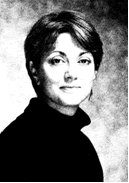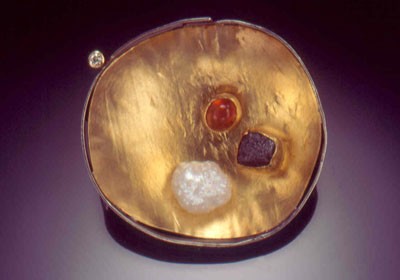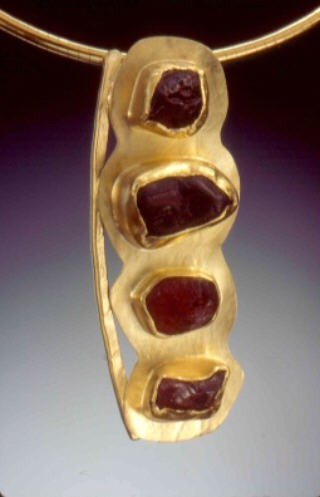The Artist as Entrepreneur |
Deborrah
Daher
|
Q. Tell me about your education. A. I have a BFA. I began with ceramics at Meramec and was a functional potter for ten years. I continued my education at Maryville and began post-graduate work at Washington University. But when the department closed, I followed my instructor, John Baltrushumas, back to Maryville. My informal education was with Sherry Jaudes, from whom I learned more current techniques. Q. Have you always worked in your current profession? A. My mother was in a retail business; she owned a fabric store. I worked there for a year and hated it, so I went to school. I worked as a potter for ten years. I was married, and my husband died quite young. It was then I switched mediums. I lost confidence - it didn't seem right anymore. So, I switched to metal and painting. I do one or two shows - then wholesale and retail. I do a holiday show with six women; we've been doing it for ten years. I learned about exhibits as chair of the exhibit committee for the Society for Midwest Metalsmiths. When you are involved with planning exhibits, you see what the jurying process is all about and you no longer take rejection personally. Q. Where is the show held? A. The Ethical Society Q. What happens during the jurying process? A. First, you learn the importance of good slides and images. The first thing they do is toss the slides that are confusing. It may be great work, but if you can't tell what you're looking at on the slide, it's out. It's worth the investment to learn how to create the slides yourself or pay to have glamour shots. Q. You went to Glamour Shots for your slides? A. (laugh) No, that's just what I call them. I paid a professional out of New York. He takes what they call a jury-shot set. They all request five shots for the jury, so he takes a cohesive shot group. Working on exhibit committees will teach you that. I'm active in all groups, including the Society for Midwest Metalsmiths. Maybe the high school students would be interested. There is a student rate to belong, and you get the newsletter.
Q. How is a market different than a show? A. Markets are shows set up as wholesale and retail. It's very expensive to participate. You have to rent your booth display, set up a retain space for yourself - you're essentially setting up a store front. You have to do your own publicity, and marketing, and books, and the financial end of it too - and taxes. You have to love to travel so that you can do shows. I learned a lot by doing these shows, and I met other artists. I jury into both sections of the Baltimore Market and Show. There are three days of wholesale trade where gallery and museum curators are invited. I didn't expect to get wholesale because I make one-of-a-kind items, but it worked out that gallery owners and exhibition curators saw my work and invited me to have shows at different galleries. After the three days of wholesale trade, there are three days of retail trade that are open to the public. In other parts of the country, people are willing to pay high prices for high-end, one-of-a-kind pieces. I did a show at the Smithsonian in 1998, and people lined up six-deep trying to buy things from us. I sold out. There is a whole different appreciation. Q. How did friends and family react when you chose to pursue this profession? A. Friends
thought it was cool, but mom and dad, who were always supportive
of my creative leanings, were worried about my ability to support
myself. Dad had a point. But, he never stopped me. He encouraged
me to get my degree, and he was always fascinated with what
I did because he was a sheet metal worker. In fact, the hammer
I use was my father's. My mother and father both worked in creative
areas - my mother with fiver and my father with metal. I start
with flat sheets of metal - I am basically doing what the two
of them were doing.
When I had taken all the classes I needed for college admissions, I was finally able to talk my way into an art class, as a senior. I also wanted to take typing, but college-track students were not allowed that, either. It was all academic, and all other stuff was devalued. I had art class once a month in grade school. The church organists came over to the school to teach art and music. The whole school would get together for the class, and we would work on projects. In school, I was a fish out of water. I did fine academically, thank goodness. I'm very organized, which is an oddity for artists. As an exhibition committee chair, I would write grants and contracts - all volunteer. I finally retired from it - came back and did it again - then quite again. It takes two years to pull the exhibition together. The Society for Midwest Metalsmiths puts on museum-quality exhibits. Watch the newsletter for the next exhibition. Q. Were you able to get grants to fund your entire exhibition? A. No. We held garage sales and approached people - galleries, suppliers, retailers - for help. Q. What advice would you give to a young adult who wants to try to make a living as an artist? A. I would suggest really strongly that you find organizations and clubs on a local level and get active, because you are going to learn so much from the people you meet. You do it your way after taking the information. We all have different ways of doing this. The organization periodicals can get your name and face out there. You have to submit slides and you have to look in these magazines to see what the quality [of images] is. For example, if you're preparing your slides yourself, don't shoot them on your aunt's quilt. You have to be motivated. You're so isolated, which is another reason those groups are so important. People act like you don't have a real job. If you decide to go into it, take it seriously and treat it like a profession. Get a phone line and organize yourself as a business. If your supplies aren't purchased through a business, you're not going to get trade prices. And, another important point - the government wants to know that you're doing what you claim to be doing. Visit Deborrah Daher's website to learn more about her thoughts about her work as as artist. More of her beautiful pieces are pictured. Part of doing business in the arts is having documents that explain your work and your experience. Deborrah has furnished her Artist's Statement, her Resume, and her Vita. As you pursue your career in the arts, keep records of your work, your publications, your awards, and so on. Be sure the documents you prepare from these records are complete and flawless. Take a look at how Deborrah has prepared hers. copyright 2004, Center for Entrepreneurship and Economic Education, University of Missouri-St. Louis |


